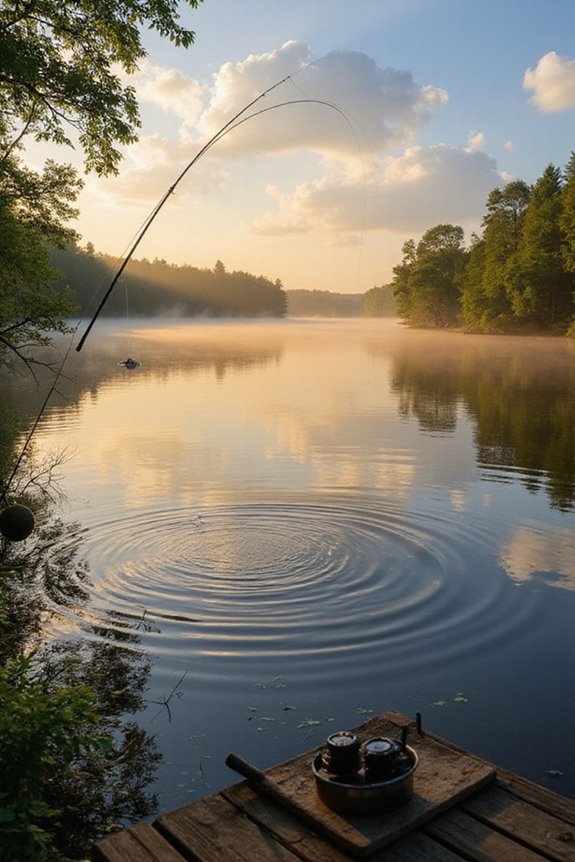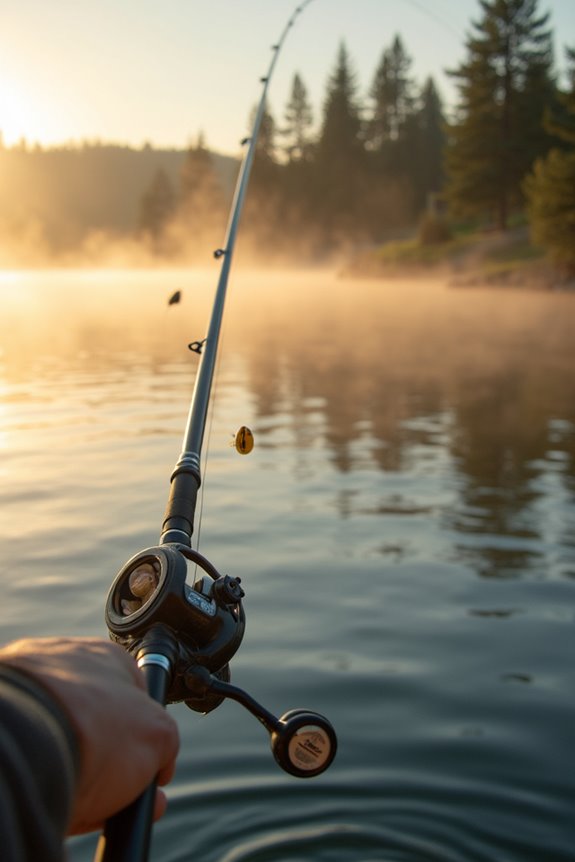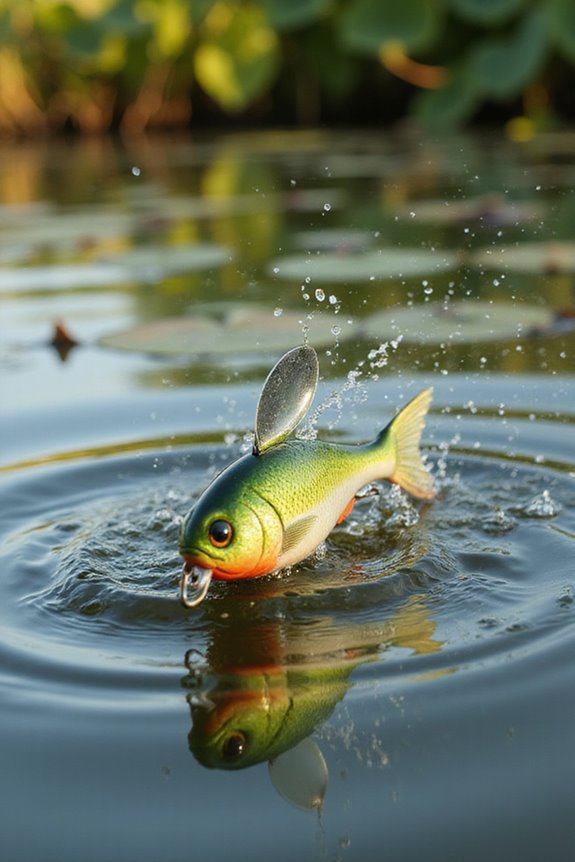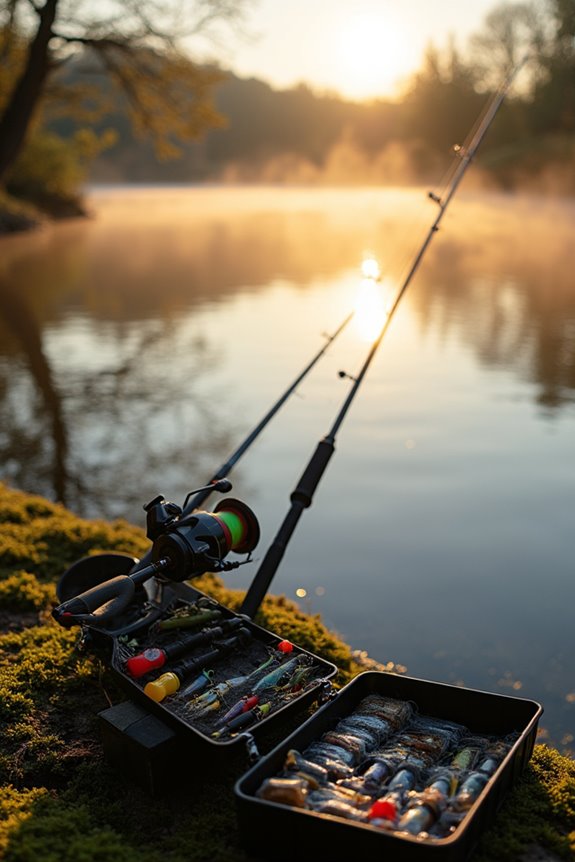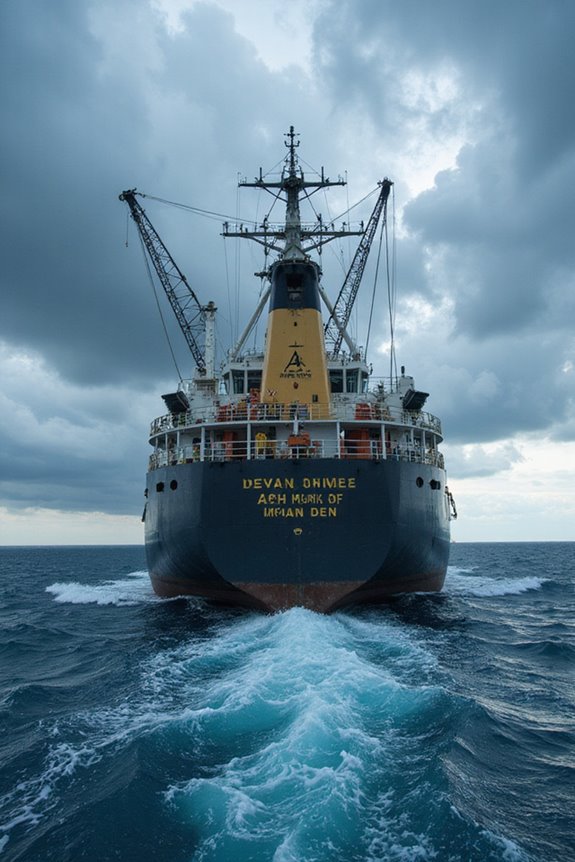Today’s fishing potential relies on key weather factors. Check the barometric pressure; the sweet spot is between 29.70 to 30.20 inches. Note if it’s falling, which could make fish more active. Consider the wind direction; target wind-blown banks where fish gather. Remember to monitor water temperature; bass prefer the range of 65-75°F. Use lures that suit the conditions, such as those with vibrations for murky water. For more insights on optimizing your fishing strategy, explore additional tips.
Key Takeaways
- Check the barometric pressure; stable or gradually rising pressure increases fish activity, while falling pressure often leads to more feeding.
- Monitor wind conditions; moderate winds can stir up nutrients and attract fish, especially near wind-blown banks.
- Assess water temperature; aim for species-specific temperature ranges to enhance fishing success, as fish behavior varies with temperature.
- Consider recent rainfall; light rain can stimulate feeding, while heavy rain may reduce visibility and alter fish behavior.
- Analyze seasonal changes; adapt your fishing techniques based on the current season and fish migration patterns for better results.
Impact of Barometric Pressure on Fish Behavior
Understanding the impact of barometric pressure on fish behavior is essential for any angler looking to improve their catch rates. Fish have notable pressure sensitivity, particularly through their swim bladders, which adjust for buoyancy. When barometric pressure drops, fish often become more active, seeking shallower waters and feeding aggressively. Conversely, high-pressure systems can lead to sluggishness, pushing fish to deeper areas where they’re harder to catch. To maximize success, I recommend fishing during falling pressure, especially before a storm, as this can trigger feeding frenzies. Use sonar equipment to locate fish at varying depths, and try lures like spinnerbaits or crankbaits to entice those more active fish. Understanding these behavioral patterns can greatly enhance your fishing trips. Experts suggest the ideal pressure readings for fishing success range from 29.70 to 30.20 inches, with fish biting best when pressure is steady or gradually rising.
The Role of Wind in Fishing Success

Wind greatly influences fishing success, just like barometric pressure does. Understanding wind patterns helps me predict fish behavior and improve my angling strategies. When the wind creates surface currents, it stirs up nutrients, enhancing bait presentation and attracting fish. I focus on wind-blown banks, which concentrate plankton and baitfish, drawing in larger predators. I pay attention to wind direction; casting downwind allows my lure to align with the current, making it more enticing. If the wind picks up, I adjust my fishing techniques, opting for heavier lures to maintain accuracy. It’s essential to avoid overblown areas, as the turbulence can make fish less likely to strike. By adapting to wind effects, I maximize my chances for a successful day on the water. Combining wind patterns with tidal movements can significantly enhance fishing effectiveness, as fish are typically more active during high and low tides when currents are stronger.
Optimal Water Temperature for Different Fish Species
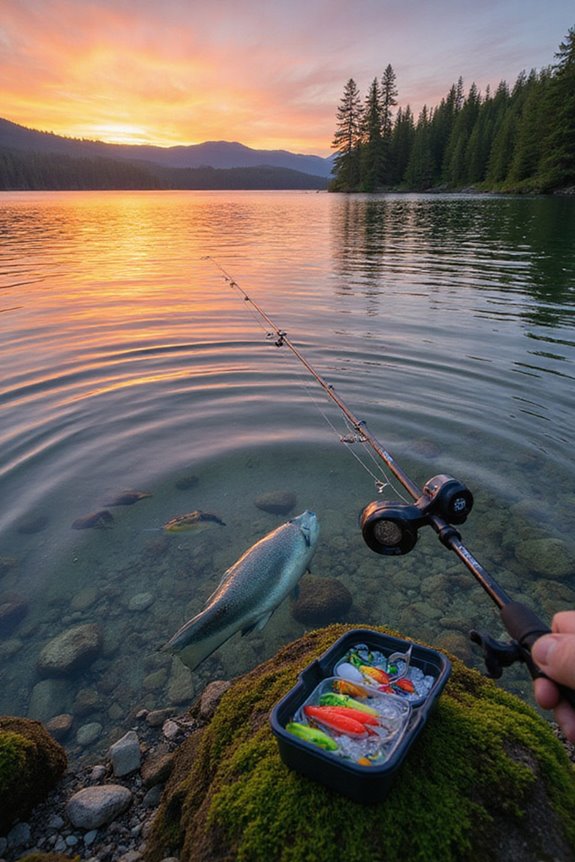
When targeting different fish species, knowing their ideal water temperature can greatly enhance your chances of success. Each species has distinct temperature preferences that impact their behavior and feeding patterns. For instance, Brown Trout thrive between 44°F and 60°F, while Chinook Salmon prefer cooler waters at 42°F to 50°F. In warmer waters, Bluegill are active at 58°F to 69°F, making them perfect targets in late spring. Seasonal behavior changes also influence where to find fish; they often seek deeper or shaded areas when temperatures rise. To optimize your fishing, use a quality thermometer to check water temperatures and adjust your techniques accordingly. For the most accurate readings, consider a digital gauge with instant read technology that provides results within 2-4 seconds. Selecting the right bait and location based on these factors can lead to more successful outings.
How Rain Affects Fish Feeding Patterns
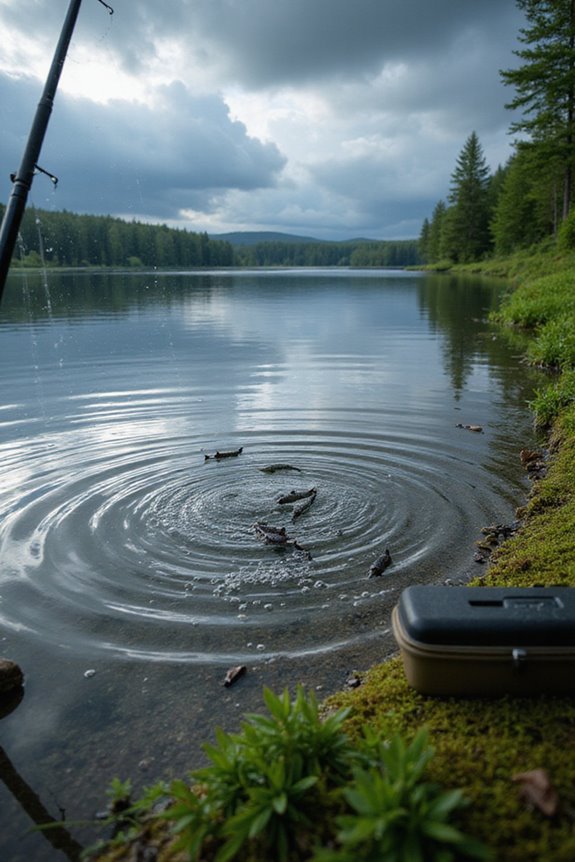
Rain can considerably influence fish feeding patterns, making it vital for anglers to adapt their strategies accordingly. Light rain introduces rain-induced nutrients into the water, stimulating feeding activity as the food chain thrives. I’ve noticed that during these conditions, fish become more active, especially before storms. However, heavy rainfall can increase rainfall turbidity, reducing visibility and altering fish behavior. It’s important to choose lures that create vibrations or contrast well in murky water. Target areas near cover where fish might seek shelter or feeding spots. Adjust your fishing techniques by using slower presentations, as fish may be more cautious in turbulent conditions. Always check local forecasts and water clarity to enhance your chances of success on rainy days.
Influence of Cloud Cover on Fishing Activity
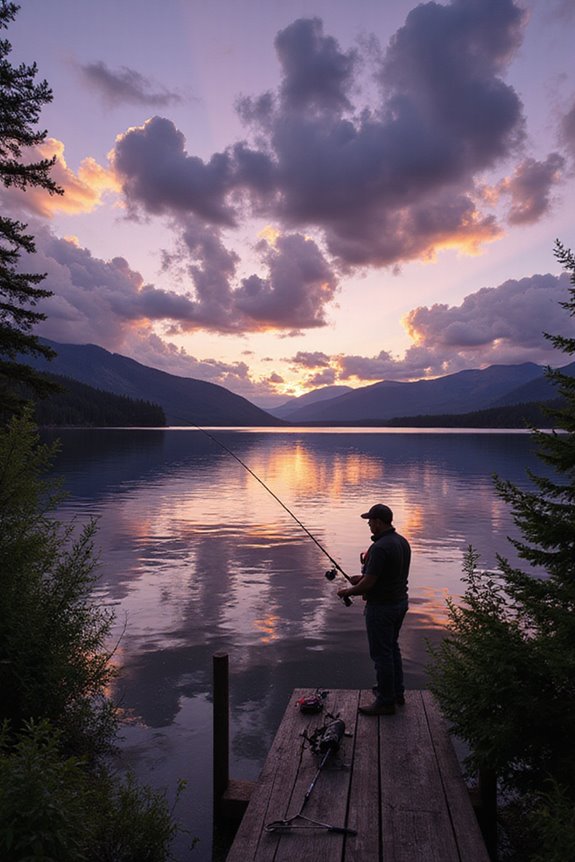
Cloud cover greatly impacts fishing activity, often leading to more favorable conditions for anglers. I’ve noticed that moderate to heavy overcast skies enhance fish feeding, especially with species like bass and carp. These conditions make fish feel secure, causing them to feed closer to the surface for longer.
When selecting fishing techniques, I prefer using topwater lures, as fish are more aggressive under cloudy skies. I opt for natural or darker baits since bright colors tend to be less effective. Additionally, I adjust my retrieve speed based on the level of cloud cover effects. Remember, clear water visibility over three feet is ideal for targeting predatory fish, so I always check that before heading out.
Understanding Water Quality and Fish Dynamics
To effectively target fish, I’ve learned that understanding water quality is vital, as it directly affects fish behavior and habitat suitability. Various factors like temperature fluctuations and oxygen levels play an important role in fish dynamics. For instance, rising temperatures often reduce dissolved oxygen, leading to increased stress and potential migration. Polluted waters can disrupt behavioral responses, making fish less aggressive and affecting their appetite. Turbidity effects also hinder visibility, complicating prey detection. To improve your success, consider using fish finders to assess oxygen levels and clarity. Fish near structures in cleaner water, and be mindful of local pollution impacts. Always check water quality reports before heading out to guarantee you’re fishing in ideal conditions.
Effects of Seasonal Changes on Fishing Conditions
Understanding how seasonal changes affect fishing conditions can greatly enhance your success on the water. In spring, rising water temperatures trigger fish migration to shallow areas, making it an ideal time to target species like trout with lures that mimic spawning prey. As summer rolls in, fish seek cooler depths; I switch to early morning or late evening trips when bites are more frequent. Fall brings aggressive feeding as fish prepare for winter, so I focus on baitfish imitations in shallower waters. Winter slows fish activity considerably, requiring slow-moving baits and careful depth adjustments. Always consider the seasonal impacts on fish behavior, as adapting your techniques can lead to more successful outings throughout the year.
The Importance of Timing in Relation to Weather
Timing is essential when it comes to fishing, especially in relation to weather conditions. I’ve learned that timing strategies directly impact fish activity. For instance, a rapid drop in barometric pressure often signals an approaching storm, and fish tend to feed aggressively during this time. I aim to fish just before a cold front when activity peaks. Afterward, as pressure stabilizes, fish movements decline. Monitoring daily time windows, such as early mornings and evenings, is vital since cooler temperatures enhance surface activity. Additionally, I pay attention to wind direction, as it influences fish locations. By understanding these weather correlations, I optimize my fishing trips and increase my chances of a successful catch.
Strategies for Fishing During Different Weather Conditions
When fishing in varying weather conditions, adapting your strategies can greatly enhance your success on the water. During cloudy days, I find fish are more active and aggressive. I prefer using moving baits like spinnerbaits and chatterbaits, which cover more water and attract those opportunistic feeders. In warm, sunny weather, fish tend to hide in cover. I switch to slower techniques, using jigs or Texas-rigged soft plastics near rocks or submerged logs. Windy days can be productive too; I position my boat into the wind and use fast-moving lures to take advantage of concentrated baitfish. Monitoring water temperature is essential; warmer temps require quicker retrieves while cooler ones call for slower, more deliberate presentations.
Analyzing Weather Forecasts for Better Fishing Outcomes
To improve your fishing outcomes, analyzing weather forecasts is essential, especially since fish behaviors are closely tied to environmental changes. I always start with weather predictions that include temperature, barometric pressure, and wind patterns. For instance, rising pressure often slows feeding, while falling pressure can trigger a feeding frenzy. I check local fishing forecasts to align my fishing trips with ideal conditions, like overcast skies that encourage surface feeding. When planning, I consider water temperature, as species like bass thrive between 65-75°F. I also monitor wind speed; moderate winds can agitate the surface, making fish more active. By combining these insights, I enhance my chances of a successful day on the water.
Frequently Asked Questions
How Does Moon Phase Affect Fishing Success?
I’ve noticed that moon phase effects can considerably influence fishing success. Following the lunar calendar helps me plan trips, particularly around full moons when fish seem more active. Timing is everything when it comes to angling!
What Role Do Tides Play in Fish Behavior?
Did you know that fish often gather in predictable spots during tide patterns? I love witnessing the feeding frenzy as currents shift, revealing their behavior—it’s fascinating how tides dictate their movement and feeding habits!
Are Certain Fish Species More Active During Specific Seasons?
I’ve noticed that seasonal patterns greatly influence fish migration. Temperature preferences dictate their activity, especially during spawning behaviors in spring. It’s fascinating how these factors shape our fishing experiences throughout the year.
How Can I Predict Fish Activity on a Given Day?
Like a wise old fisherman once said, “Read the water.” I check water temperature and barometric pressure daily; rising pressure usually means slow fishing, while falling pressure often sparks activity. Timing’s everything, you know.
What Gear Adjustments Should I Make for Different Weather Conditions?
When considering gear recommendations, I always adapt based on weather impacts. For windy days, I use heavier weights, while calm conditions call for lighter tackle. Matching my lures to conditions guarantees a successful fishing experience.

